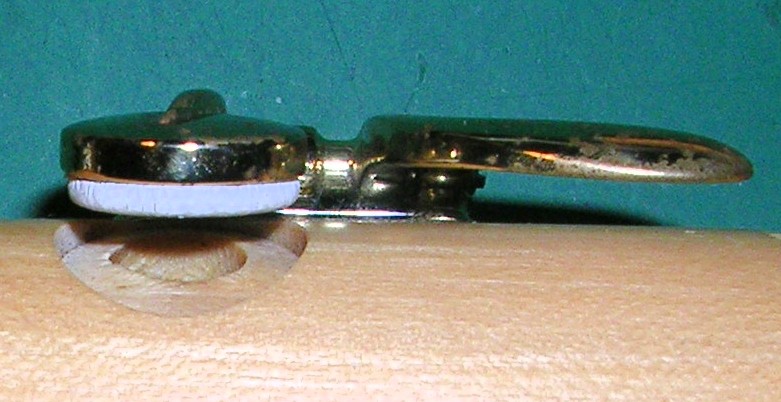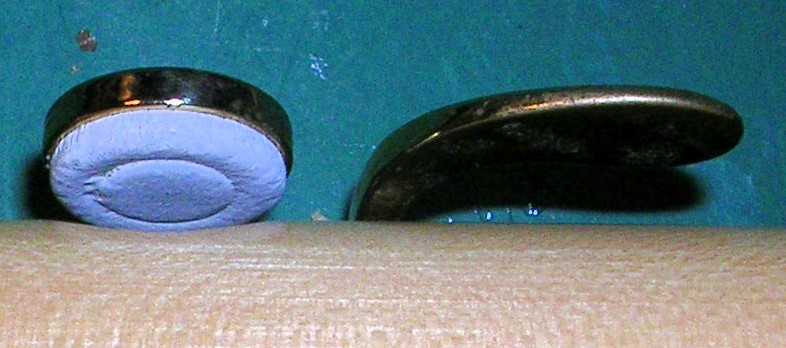Saunders Recorders
Bristol UK.
A damaged 'Comfort Tenor' keyed hole.
This page is about the need for perfection when it come to covering the holes of a wind instrument.
To my surprise, this comfort tenor key is working well enough.
Look closely at the left rim of the hole and you will see that the curve moves away from the expected line

It is not easy to see. The pale patches at the edge of the rim are where wood has been splitered away.
This recorder came to me for a new cork joint. I looked it over but I did not want to run the risk of being responsible for anything else.
I could have got better pictures but I decided not to remove or disturb the key in any way.
Scroll down for a view of the pad.

The white leather pad clearly shows the indentation made by contact with the rim of the hole. It should not have left the factory like this but the indentation shows no sign of ever having been a true unblemished circle. What do you think?
Damage like this to a hole usually results in an air leak. The leather (in this case) covering of the pad is likely to bridge over rather than fill any grooves left by missing wood fibres. The smallest air leakage will destroy the resonance of notes that depend on this hole being closed. The usual result is a weak sound or a harmonic.
This recorder is playable but I think it is a very close call. The very refinement intended to solve the problem of a finger covering the hole could very well have had the opposite effect.
There is a back story to this issue.
I am going to be deliberately vague, no names...
A long time ago (before comfort keys were fashionable) I sent several very big recorders back to the manufacturer because they exhibited this fault. It was linked to the difficulty of cutting the particular hardwood used. We talked face to face at an exhibition and I showed him the fault on some of his display recorders. He was not happy but we parted on cordial terms. I softened my stance by agreeing not to return any recorders that showed this defect but did actually play without problems.
My (unstated) solution was not to order any more big recorders made of that wood.
Their (later) solution was to use metal inserts.
Hard woods are a much better proposition for the creation and retention of fine detail than softwoods. There is very little trouble with orchestral woodwind, clarinets and oboes are usually made from grenadilla. I played a cocus wood Boehm flute in my youth. The main holes are around 15mm in diameter. My teacher showed me how to check and maintain it. As a result, I am very fussy when it comes to padding. Maple is a soft wood and great care must be taken of the hole edges. Pear wood is a better bet. It takes a finer cut and is less likely to splinter. (Bassoons are made of maple and do tend to suffer from hole damage and rot. Unlike recorders, it is usual for bassoons to be varnished over the virgin wood exposed by the cutting of tone holes for pads.)
If you have a wind instrument that is 'difficult' to play, it may have leaking keys. The problem can usually be resolved by replacing pads and/or reworking the pad seating rings.
I once did this to all 17 keyed holes of a brand new custom made wooden clarinet that just would not play to match the owner's expectations. Returning it for 'adjustment' had not had the desired effect. I had a reputation for problem solving, and the owner found me. With a powerful magnifier and great care I checked every hole and pad, reshaping and removing blemishes. The result was dramatic and a revelation. I discussed this with an experienced repairer at a prominent woodwind dealership. He laughed and told me I had turned a £1000 instrument into a £3000 instrument. (Or words to that effect.)
In my teens I knew a lady who had the same model wooden flute as mine. She was a good player, but her flute felt different and refused to play top F# with the standard, fingering. The alternative fingering worked fine. It was not a 'regulation' fault. She eventually acquired another flute. Forty years later she came into the shop with her old wooden flute and asked me to re-furbish it. She wanted to play it again, for old time's sake, and trusted me. I remembered her flute and its unusual feature. I don't know what in particular I did, just the full, careful, works, but the problem was gone. (Her flute had been to various specialist flute repairers in its time but none had cured the top F# issue.)
A wind instrument with keys and other features can also suffer on account of small leaks from unexpected places. Fixing screws often penetrate the bore and there is no guarantee that they seal the hole they occupy. The Devil is in the detail. There are times when mechanical pefection is a necessity. It brings its own rewards.
With hole damage too great to be simply reworked, an insert, of suitable wood or plastic, would be an answer. Rather like a replacement tooth, it would need to be made and fitted by a specialist, preferably one able to make a complete keyed instrument. I think the hole that is the subject of this page falls into this category.